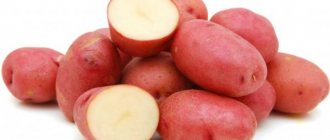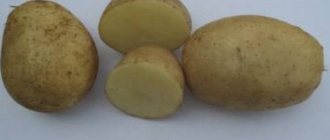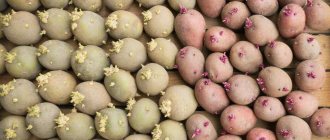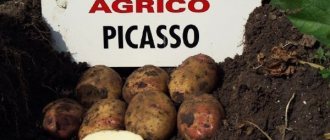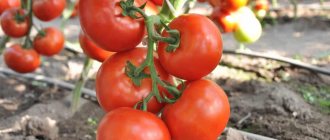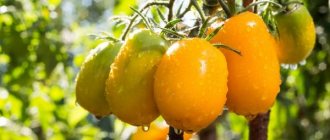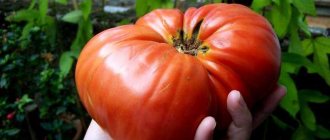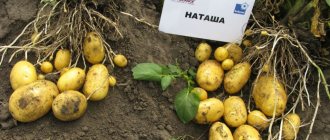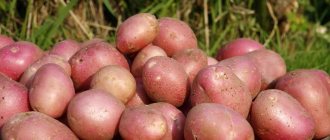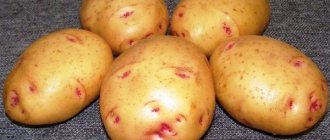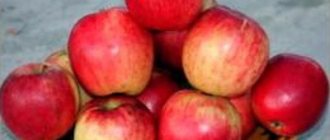The description of the Gourmet potato variety should begin with its main feature - the purple color of the tubers. Moreover, the unusual color is inherent not only to the peel, but is also clearly visible on the cut. Color is not the only difference between Gurman and ordinary potatoes. Brightly colored tubers have a unique composition and are very beneficial for the human body. The domestic variety was obtained using conventional breeding methods and does not belong to genetically modified plants.
Description of the potato variety Gourmet
Purple potatoes were obtained relatively recently and have not yet been included in the State Register, but have already spread throughout Russia. Today, the variety can be found not only on private plots, but also on farm fields.
The Gourmet variety is a mid-early variety; the tubers ripen in an average of 90 days. Excellent keeping quality will allow you to transport tubers and store them all winter.
Characteristics of Gourmet potatoes:
- the peel is dense, smooth, dark purple;
- the flesh is unevenly colored, the purple color is diluted with white inclusions;
- fruit shape is oval, highly elongated;
- eyes sparse, weakly expressed;
- the weight of an average tuber is 90 g.
Gurman bushes are medium-sized, not spreading, the tallest stems reach 70 cm. White potato flowers are decorated with black stamens. The leaves on strong stems are small and light. On average, from 10 to 14 tubers are tied under one bush.
Characteristics
“Gourmet” refers to “colored” types of potatoes with a medium-early ripening period.
The growing season lasts for 75 - 80 days from the moment the first shoots appear.
It was created relatively recently in Ukraine through the selection of several other varieties (detailed information about its selection has not yet been distributed), and has not yet been included in the State Register of the Russian Federation.
However, this does not in the least prevent many gardeners from growing it on their plots in different regions today.
It has good productivity; up to 40 tons of potatoes can be harvested from one hectare of crops . The keeping quality didn’t disappoint either, you don’t have to be afraid to leave it in the cellar for the winter.
Read more about how to store potatoes in winter, on the balcony or in drawers, in the refrigerator or peeled in the articles on our website. And also what deadlines need to be observed, what temperature is optimal and what problems may arise when storing potatoes.
You can compare the yield indicators of Gurman with other varieties in the table below:
| Variety name | Productivity |
| Gourmet | up to 400 c/ha |
| Elizabeth | 80-140 c/ha |
| Vega | 90-120 c/ha |
| Colombo | 80-130 c/ha |
| Lugovskoy | 80-165 c/ha |
| Irbitsky | 108-185 c/ha |
| Borovichok | 200-250 c/ha |
| Lapot | 400-500 c/ha |
| Sturdy | 78-105 c/ha |
| Crimean rose | 75-120 c/ha |
| Agatha | 70-140 c/ha |
Taste qualities of potatoes
In addition to its exotic appearance, Gurman is endowed with an unusual taste, which when baked takes on a nutty hue. Raw potato pulp is also eaten. Sliced tubers without heat treatment can be the basis of various salads.
Comment! The color of the pulp of the Gurman variety does not lighten during cooking. Potatoes become almost black when cooked.
The starch content in tubers is much lower than that of regular potatoes. Most often, the figure does not exceed 13%, which makes the variety suitable for dietary nutrition. The presence of a significant number of carotenes and substances exhibiting antioxidant activity allows us to classify such potatoes as products beneficial for human health.
Gourmet is recommended to be included in the diet for diabetes, metabolic disorders, and increased body weight. The rich chemical composition of potatoes is useful in the prevention of cardiovascular pathologies, hypertension, atherosclerosis, and ischemic heart disease. It is useful to replace ordinary root vegetables with purple ones when visual acuity decreases.
Features and useful properties
Characteristics:
- “Gourmet” is a mid-early table variety, the growing season is 75-80 days;
- The yield of the variety reaches 35-40 tons per hectare;
- Potato juice contains a high percentage of dry matter, and the taste properties of root vegetables are different from other varieties;
- The “Gourmet” variety is a dietary product, since the tubers contain antioxidants that remove radionuclides from the body;
REFERENCE: By regularly eating this variety, you can reduce the level of diseases of the cardiovascular system and strengthen the walls of blood vessels.
- Potatoes can be eaten raw.
Pros and cons of the Gourmet variety
Potatoes of the Gourmet variety, according to reviews from amateur gardeners and farmers, have a number of undoubted advantages:
- Ability to bear fruit well in any region suitable for potato growing.
- Preservation of presentation until spring for 90% of root crops.
- Disease resistance.
- High yield.
Disadvantages include susceptibility to late blight in humid climates. This feature requires additional treatment of plantings with Bordeaux mixture during prolonged rains.
Important! In the western regions and north-west of the country, Gourmet is recommended to be sure to etch and germinate before planting.
Landing Features
To get a good harvest from the Gourmet variety, you should follow the standard rules of agricultural technology when planting and caring for the crop. Potatoes of the type described do not like cold. The air temperature, which has dropped to +10 degrees, is very unfavorable for plants.
Landing dates
Gourmet potatoes are planted in early spring. The planting time depends on the characteristics of the growing region. It is necessary to wait until the air temperature rises to + 12 degrees and the threat of night frosts on the soil has passed.
Seed preparation
Before planting the Gourmet variety, large, healthy tubers should be selected. Next, the seeds must be pickled in Bordeaux mixture for 1 hour. Then the seed roots are placed in a bright, dry room and left to germinate. When the potatoes sprout 1 cm long, they can already be planted.
Site preparation
The Gourmet potato variety can grow on soil with any characteristics, however, the greatest yield is harvested when the crop is cultivated on a loose, slightly acidic type of soil. The place in the garden where the potatoes will grow should be chosen as sunny. Light partial shade is allowed. An important characteristic of a potato plot is the depth of groundwater, which must be at least 1 m to the soil surface.
It is recommended to plant the Gourmet variety on the ground where carrots, legumes, onions, garlic or green manure crops were grown before, cultivating the soil. The soil must be prepared in the fall by carrying out the following work:
- Removing weeds from the area.
- Digging the soil to a depth of at least 35 cm.
- Application of organic fertilizers (simultaneously with digging).
Fertilizers include humus or compost in an amount of 5-7 kg per 1 square meter. meter. In the spring, the soil is dug up again and mineral fertilizers are applied: superphosphate, potassium sulfate, 1 tbsp. l. per square meter.
Planting scheme
The Gourmet variety is planted to a depth of 5-10 cm, using a standard scheme with the following characteristics:
- between plants – 40 cm;
- between rows – 60 cm.
When planting small potato tubers, the interval between plants can be reduced to 30 cm.
Planting and caring for Gourmet potatoes
Gurman has few special features in agricultural technology. One of them is the requirement for heat. Air temperatures below + 10 °C are detrimental to the plant. The short growing season allows the Gourmet variety to be grown in various climatic zones, but potatoes develop and bear fruit best in temperate and southern regions.
Selection and preparation of a landing site
Potatoes of the Gourmet variety prefer slightly acidic soils with a loose, breathable structure. To obtain excellent yields, any soil can be improved.
Several principles for selecting and preparing beds:
- Peaty, sandy and loamy soils are the best choice for the Gourmet variety. If the sand content is too high, it is necessary to create a fertile layer artificially by introducing humus or rotted manure into the soil.
- On heavy loams, it is important to ensure that the top layer of soil is loose. Sand, peat, and rotted leaves are added to the beds for digging. It is necessary to maintain the top layer of soil in a loose state throughout the entire season; mulching copes well with this task.
- Open, sunny areas are preferable for planting, but partial shade is possible in hot climates.
The Gourmet variety loves abundant moisture and, with good watering, can bear fruit in the hottest climates. Despite this, you should not choose lowlands with high humidity for planting, where potatoes tend to get sick. In conditions of frequent natural rainfall, it is better to place the Gurman on slopes with free outflow of rainwater.
Preparation of planting material
Gourmand is a young, unusual variety, the planting material of which is more expensive than the usual potatoes. If possible, you should choose large tubers and preferably plant them. Small specimens are prepared as standard, but planted with a slight thickening.
Pre-planting preparation of Gurman tubers:
- selection of healthy, undamaged potatoes without spots and growths;
- pickling the tubers in a solution of mineral fertilizers or Bordeaux mixture for at least 60 minutes;
- planting for germination in a bright room with spraying of young sprouts every few days.
The appearance of strong, young sprouts about 1 cm long indicates that the potatoes are ready for planting. Overgrown shoots should be shortened. It is better to remove thin sprouts that appear during storage in the dark.
Landing rules
Take the potatoes out into the open air in advance, preferably several days in advance. At temperatures above + 10 °C and sunny weather, the tubers are warmed up, preventing the young shoots from drying out.
On prepared beds, tubers are buried to a depth of 5 to 10 cm. The planting scheme for the Gourmet variety suggests leaving a distance between holes of about 40 cm and 60 cm between rows. Small potatoes are planted more often, at intervals of up to 30 cm.
Watering and fertilizing
For Gourmet potatoes, both excess and lack of moisture are critical. In dry seasons, additional watering will be required at least 2 times during the growing season.
Rules for watering the Gourmet variety:
- from the moment of planting until the emergence of seedlings, additional moisture is not required for potatoes;
- the first watering can be carried out when friendly shoots appear;
- the second time, the plantings are abundantly moistened during flowering;
- Regular watering is needed if there is insufficient precipitation during the period when the tubers are gaining mass.
Important! Not only the yield, but also the taste of potatoes depends on the quality of watering. If there is an excess of moisture, the Gourmand’s pulp becomes insipid; if there is too little, the potatoes will be small.
It is convenient to combine watering with fertilizing. It is important to first moisten the soil with clean water and then sprinkle it with fertilizers so that the mineral compounds do not burn the tubers. It is best to feed potatoes with superphosphate, saltpeter, urea, potassium chloride, nitrophoska, diluted according to the instructions.
Loosening and weeding
The Gourmet variety is sensitive to the formation of soil crust on the soil surface. After each watering or heavy rain, the beds should be carefully loosened. Treatment is only permissible superficially, so as not to damage the roots or young tubers.
Mulching not only solves the problem of drying out the top layer of soil, but also conserves moisture and prevents weeds from actively growing. Weeding in such beds can be done less frequently, and after the tops are closed, it can be stopped altogether. You can mulch potatoes with grass clippings or weeds without seeds.
Hilling
An important agrotechnical technique for caring for potato plantings ensures additional root growth, prevents soil and stems from drying out, and increases productivity. Early earthing up of Gurman bushes can protect plants from returning cold in an unstable temperate climate. In this case, it is permissible to cover the sprouts entirely with soil.
The next hilling is carried out depending on the growth rate of the bushes, preferably before the onset of the flowering phase. Gourmet stems can be sprinkled with moist soil up to half their height.
Once the plant has formed and the potatoes have set, additional soil may be needed. This is how they form falling bushes or cover surface tubers from the sun.
Peculiarities
The first feature of the “Gourmet”, of course, is its color, but if you thought that the differences ended there, then you were very mistaken. As mentioned above, potatoes of this variety have very little starch content.
The reason for this is that in return it contains a large amount of antioxidants , which are so beneficial to our body. The fruits of “Gourmand” are an extremely useful product, which in general has a very positive effect on human health and even rejuvenates it.
IMPORTANT! Another amazing property of this potato is that it can be consumed raw. It is perfect as an addition to various salads.
It is considered a dietary vegetable , which can be included in the menu of people suffering from diabetes or obesity. In addition, it is recommended for use for the prevention of malignant and benign tumors, ischemia, atherosclerosis, hypertension, visual impairment, and improper metabolism.
If we talk about the agrotechnical characteristics of the plant, then first of all it is worth noting that it is suitable for cultivation in moderate or arid climatic conditions.
This is due to the fact that it is demanding of warm weather (temperatures below 10 °C will have an extremely negative effect on the plant) and a sufficient amount of moisture in the soil.
Therefore, if there has been no rain in your area for a long time, then get ready for manual watering. “Gourmet” prefers sandy loam, peaty and slightly loamy soils.
For planting, it is better to select larger tubers and plant them according to a 60 x 30 pattern (the distance between rows is 60 cm, and between planting material in rows is 30 cm). The digging depth should be about 5 - 10 cm.
IMPORTANT! The plant will need moisture after the first shoots appear and during flowering. Immediately after planting, you don’t have to worry about watering, since the spring soil will still retain a large amount of moisture.
The best fertilizers are superphosphate, ammonium nitrate, nitrophoska and potassium chloride.
Read more about how to fertilize potatoes, how and when to fertilize, and how to do this when planting.
Also, do not forget about loosening the soil; these potatoes really do not like the formation of a crust on the surface of the soil. Mulching will help control weeds. Otherwise, caring for “Gourmet” is not much different from caring for other mid-early varieties.
Read about how to grow early potatoes here.
In addition to the use of various types of fertilizers, other substances and preparations for spraying are often used when growing potatoes. Read on our website everything about the use of fungicides, herbicides and insecticides, their benefits and harms, methods of application.
There are many ways to grow potatoes. We have prepared detailed articles for you on how to grow potatoes without weeding and hilling, using Dutch technologies, under straw, in bags, in barrels or boxes, from seeds.
Diseases and pests
The young purple variety has strong immunity to potato cancer and scab. The variety is relatively resistant to late blight and fungal infections. However, the variety remains sensitive to viral diseases, so measures should be taken to prevent infection.
The following measures prevent diseases in Gourmet potatoes:
- timely weeding;
- destruction of harmful insects that spread viruses using modern insecticides;
- compliance with crop rotation, with regular replacement of crops that do not have common diseases and pests.
Advice! To protect young Gourmand sprouts from the attack of the Colorado potato beetle, experienced gardeners advise treating potatoes before planting.
Spraying tubers with special preparations, for example, Prestigator or Prestige, also protects against wireworms and major diseases.
Diseases and parasites
One of the important characteristics of the Gurman variety is good immunity to many diseases of vegetable crops. Potatoes are not sensitive to potato cancer and scab. It is relatively susceptible to late blight. The Colorado potato beetle or mole cricket can attack any variety of potato, including Gourmand.
Late blight
The causative agent of the disease is a fungus that adapts to life on various plants - potatoes, tomatoes, eggplants, and leads to the death of crops if no control measures are taken.
It is necessary to carry out preventive measures. Before planting, Gourmet potato seeds are treated with fungicidal preparations. The soil on which the crop is planned to be planted is also cultivated.
Characteristics indicating late blight:
- the appearance of brown spots on stems and foliage;
- the formation of a gray-white coating on the back of the leaves;
- brown, brown spots on root vegetables;
- rotting of tubers.
This fungal infection affects plants that have a deficiency of phosphorus and potassium, or an excess of nitrogen fertilizers. May appear from excessive humidity. At the primary stage, the variety can still be cured by treating the bushes and soil with fungicides. When neglected, the disease is incurable, and the plants must be destroyed.
Medvedka
A dangerous insect that attacks various cultivated plants, including potatoes, is the mole cricket. The pest gnaws the stem and the bush dries out. This parasite can gnaw out large cavities on tubers, making them unsuitable for storage and consumption.
If the characteristics of a mole cricket invasion on the Gourmet variety are detected: dead potato bushes, as well as holes on the surface of the bed, pest control should begin. Various chemicals are used that have repellent and destructive properties for the parasite. Medvetox and Grizzly products are effective.
Traditional methods of fighting mole crickets include traps made from sweet baits in the form of sugar water or honey. In addition to sweets, the pest loves beer. You should bury a glass jar with bait in the ground. The mole cricket falls into a trap from which it is impossible to get out.
Colorado beetle
The Colorado potato beetle, which attacks potatoes, is a very dangerous insect that can cause significant damage to plantings. The parasite eats leaves, stems, and tubers of vegetables.
When planting in small areas, Colorado potato beetles can be collected by hand. Then destroy the collected pests by pouring kerosene. When planting large areas, chemicals Colorado and Prestige are used, which have protective characteristics.
Potato yield
The gourmet is highly productive. With full agricultural technology, up to 15 tubers are tied under each bush. With sufficient moisture and soil fertility, one potato can grow larger than 100 g.
The overall yield of the variety is higher than the average for potatoes: from 1 sq. m get up to 4 kg. Under average conditions and lack of care, the crop is guaranteed to provide 1 kg of tubers per bush.
Proper planting of purple potatoes
Basic landing rules:
- The highest yields can be achieved in regions with a temperate and arid climate, as well as sandy, peaty and slightly loamy soils;
- Give preference to large tubers as seed material;
- Planting should be done in soil heated to 10 °C. Temperatures below this level negatively affect growth and lead to the death of the bush;
- The distance between the bushes should be at least 30 cm, and the row spacing should be 60 cm. The seed should be buried 5-10 cm.
Harvesting and storage
Gourmand bears fruit well in a variety of soils and is capable of producing early harvests, which distinguishes it from other varieties. The first, young potatoes can be dug up 40 days after the sprouts appear. If the climate allows, then fully ripened potatoes can be harvested after 110 days.
On average, it takes Gurman 85-90 days for the tubers to fully ripen and form a dense peel. After this period, the harvested potatoes are suitable for long-term storage. The variety has good keeping quality and, in a cellar or well-ventilated basement, is perfectly preserved until spring.
The material selected for planting should be greened immediately after collection. To do this, Gurman tubers are kept in a lighted place (avoiding direct sunlight) for at least 10 days. Greened tubers do not germinate in winter, are not damaged by rodents, sprout quickly, and the grown bushes are less sick.
Care
How to care:
- "Gourmet" needs sufficient moisture in the soil. If there is no rain for a long time, manual watering is necessary. Immediately after planting, potatoes do not need watering, since the spring soil still contains a sufficient amount of moisture. Watering is necessary as soon as the first shoots appear, as well as during the flowering period;
- Required amount of fertilizer applied per bush: 5.5 g of superphosphate, 3.5 g of potassium chloride, 2.5 g of ammonium nitrate or 11 g of nitrophoska;
- Regularly loosen the soil, as this variety does not tolerate the formation of a crust on the surface of the soil;
- To combat weeds, resort to mulching.
Potatoes with colored pulp:
Characteristics of the variety
It is not without reason that early gourmand is popular among winegrowers - it has many positive qualities:
- stable high yield (6–8 kg per bush, 200–201 c/ha);
- marketable appearance and excellent taste of berries;
- good preservation of berries on the bush;
- high resistance to fungal diseases (mildew, oidium, gray rot);
- resistance to transportation and storage.
The disadvantages of Gourmand early include the female type of flowers, which is why planting pollinator bushes is necessary. The hybrid is considered a covering crop, although its winter hardiness is not so low - down to -23...-24 oC.
"Blue"
The “Golubizna” variety is a mid-season, tall, erect bush, with many stems and dark green leaves. It blooms for a long time with blue flowers, but does not form berries. The peel is white mesh, the flesh is white. The tuber is round with a sharp tip, numerous small eyes. The starch content is high - up to 19%. Drought resistant. Recommended for the Center of Russia, perhaps that is why the variety did not reveal its advantages. There is no potato aroma when cooking. Productivity is much lower than "Adretta" and "Bronnitsky". 10-12 tubers is not enough.
Blueberry tuber, raw without peel
Frying Blue and Gourmand slices
For greater clarity, I peeled two tubers - “Blue” and “Gourmet” and fried them a little. I will write about purple potatoes of the “Gourmet” variety below. They don't fall apart, they both keep their shape.
Gourmet - miracle potatoes on your table
Exotic and very popular variety! In many countries, rejuvenating face masks are made from this potato. Appetizing, plentiful, giving a lot of scope in cooking, potatoes are loved by almost everyone. In addition to their great nutritional value, potatoes are rich in vitamins.
Potatoes have a lot of useful properties. However, despite the enormous importance of potatoes as a product, many people simply refuse potato dishes due to their high content of starch and carbohydrates. Some people protect their figure, while others cannot afford this product due to health conditions.
In this regard, from year to year the direction of agriculture associated with the creation of dietary types of potatoes with multi-colored pulp: purple, reddish, pink and blue is developing more actively. At the moment, such potatoes are considered a curiosity, akin to the best delicacies. Dishes made from colored potatoes are served in restaurants in Europe and America. In some countries, these varieties are actively used by chip factories; their highlight is purple chips without dyes.
Pests and diseases
Purple potatoes are not susceptible to diseases such as scab and potato cancer. With proper care, bushes are practically not affected by rot. But viral infections can become a serious problem if preventive treatment is not carried out in time. First of all, you need to get rid of all the weeds and keep the area clean at all times. Don’t forget about pest control using the most effective drugs.
An excellent remedy is “Prestigerator”. It will help get rid of not only the Colorado potato beetle and wireworm, but also protect the potatoes from many diseases.
Comment! To minimize all risks, you need to follow the basic rules of crop rotation and use only high-quality planting material.
Potatoes for health
Such potatoes, of course, are not considered a medicine, but they are a good preventative measure for almost all diseases.
Its main secret is its low starch content and high (relative to ordinary types of potatoes) content of antioxidants: anthocyanins and carotenoids. Moreover, the more intense the color of the tubers, the higher their antioxidant content.
Studies conducted in US clinics and institutes over the past 10 years have shown the beneficial effects of such potatoes on the human body, namely:
- daily use of potatoes with multi-colored pulp reduces the risk of cancer and atherosclerosis;
- strengthens the walls of blood vessels;
- will have a positive effect on vision.
It has been confirmed that in potatoes with colored pulp, the antioxidant capacity is 6-7 times greater than in ordinary tubers with snow-white or yellowish pulp.
This means that by introducing this dietary type of potato into their daily diet, people will be able to eat their favorite vegetable and help the body fight harmful radiation, carcinogens and other drugs. In particular, such potatoes are indicated for overweight people, unhealthy diabetes, as well as the elderly and children. That is why the Becker company considers potatoes with multicolored flesh to be a very promising course in potato growing .
Multi-colored potatoes A connoisseur of good cuisine combines extraordinary appearance, good taste, benefits for well-being, novelty and unusualness. Don’t forget about it when purchasing potato tubers for planting; grow a miracle vegetable on your own, even before it becomes popular in our country.
Potatoes through my eyes... How I planted them and chose varieties. Part 2
Potato varieties
According to ripening time, all varieties are divided into 5 groups:
- early with a ripening period of 80-90 days
- mid-early (90-115 days)
- average (115-125 days)
- medium-late (125-140 days)
- late (more than 140 days)
When selecting a variety, these terms must be taken into account in order to regulate the time for germination of tubers and planting them in the ground.
Using the right technique, you can reduce germination time and speed up the emergence of seedlings. The result is early and tasty tubers. It should be noted that these dates are subject to change, just like our weather in temperate climates. Typically, tubers ripen faster, this is confirmed every year. In the photo there are 5 varieties that I highlighted due to their taste. In the first part of my story, I mentioned the “Rosara” with large oval pink tubers. It contains a low percentage of starch, so the pulp takes on the taste of undercooked potatoes, the potato pieces become transparent and hold their shape perfectly. It is ideal for making chips. In contrast, the 5 varieties in the photo are high-starch.
Ads by
"Adretta"
“ Adretta ” is a mid-early table variety.
Bred in Germany. It appeared in Russia in the nineties and quickly spread due to its excellent taste, which made it unlike other varieties. Adretta is characterized by fast growth, early tuberization and high yield. It blooms with large white flowers and produces numerous berries. You can select early tubers from under the mulch as early as 70 days after planting. The bushes are erect, with multiple stems, the leaves are large, light green. When using mulch with further “unhilling”, the stems reach a height of more than a meter. Therefore, in ordinary beds it is necessary to make the distance between the rows at least 90 cm. “Adretta” in the basement for storage
Starch content - up to 17.8%. The tubers are round, yellow, the flesh is light yellow. The eyes are small. During storage, the peel is covered with a mesh pattern. Sometimes I heard that Adretta is not kept very well. Under the right conditions, it lasts until spring. I think the reason lies only in the storage conditions! This variety is resistant to cancer pathogens and relatively resistant to viruses. Susceptible on tops and moderately on tubers to the causative agent of late blight. Suitable for almost all cultivation zones.
Taste is the advantage of “Adretta”. The tubers cannot be peeled or boiled; they are not at all suitable for first courses, since the potato pieces do not hold their shape. But for puree soups this is the most suitable option! “Adretta” is the queen of steaming “in uniform”. You can bake raw Adretta, just don’t actively turn it over. It cooks well just in a saucepan with a small amount of water at the bottom and over low heat. By the way, it cooks very quickly. Then, peeled and placed on a baking sheet in the oven or simply in a frying pan, it shows itself.
Boiled and fried “Adretta” Tip! Asafoetida combined with shamballa or fenugreek leaf helps digest starchy foods, as do cumin and ground coriander. When heated in oil, the aroma of onion and garlic inherent in asafoetida spreads far. This cooking method allows you to get another potato dish that is new and tasty.
Asafoetida and Shambhala leaf Shambhala seeds germinate well, you can cut and dry the greens. There are also ready-made bags of dried fenugreek. Asafoetida, unfortunately, is now produced with lids that do not close tightly (left). Therefore, it is better to additionally place it in the package. On the right is the packaging that was there before.
All young summer tubers are tasty, it is difficult to distinguish them, so I brought them from the basement and boiled them now that they were ripe enough. Then they cooled down, this is the only way to experience the real taste of potatoes.
Boiled tubers None of the varieties turn dark after boiling. Everyone was given separate cooking utensils; mixing of flavors was excluded. It’s hard to work with tasters these days; if you invite them, they’ll suddenly misunderstand...))) Therefore, I rely on the taste of my husband, a big “latter” of potatoes, especially boiled ones. Just such a taster can carry out an organoleptic examination objectively. Well, I’ll try again... Moreover, we need to determine which varieties we will leave in the garden.
"Bronnitsky"
The next variety - "Bronnitsky" - is mid-season, spreading, tall, forms many stems , blooms well with blue-violet flowers and produces berries.
The taste is excellent, starch content is up to 16%. The tubers are oval-round with a smooth light yellow skin. “Bronnitsky” The eyes are quite “recessed” and numerous. When used in the kitchen, this feature interferes if you need to quickly remove the peel with a vegetable peeler or knife. This variety is rarely sold in markets, all because of the shape of the tuber and eyes. When boiled with the peel, the tuber is easy to peel; its skin is very thin.
"Bronnitsky" boiled
Very aromatic potatoes, you rarely see one like this these days. Its advantage is its versatility in various dishes and excellent taste. It stores well, is resistant to cancer, relatively resistant to scab, and not resistant to potato nematode. Recommended for the Center of Russia, the Volga region, and the Krasnoyarsk Territory.
"Blue"
“Golubizna” variety is a mid-season, tall, erect bush, with many stems and dark green leaves.
It blooms for a long time with blue flowers, but does not form berries. The peel is white mesh, the flesh is white. The tuber is round with a sharp tip, numerous small eyes. The starch content is high - up to 19%. Drought resistant. Recommended for the Center of Russia, perhaps that is why the variety did not reveal its advantages. There is no potato aroma when cooking. Productivity is much lower than "Adretta" and "Bronnitsky". 10-12 tubers is not enough. Blueberry tuber, raw without peel
Frying Blue and Gourmand slices
For greater clarity, I peeled two tubers - “Blue” and “Gourmet” and fried them a little. I will write about purple potatoes of the “Gourmet” variety below. They don't fall apart, they both keep their shape.
"Lyubava"
The variety "Lyubava" is early ripening.
The taste is stated to be good. But despite the declared “excellent” taste of “Golubizna,” it is precisely “Lyubava” that has a potato spirit when cooked. "Lyubava" Bushes of medium height, semi-erect. The tubers are oval-round with eyes of medium depth. The peel is red, rough to the touch, the flesh is white. Starch content up to 16.9%. The advantage of the variety is high yield and uniform formation of tubers. Already on the 45th day it can produce an early harvest. So I pulled out the first tubers from the box bed.
“Lyubava” baked with rutabaga in cream in a country electric oven
You can boil, fry, and stew. The variety is resistant to the potato canker pathogen, but susceptible to the golden nematode. Stores perfectly.
"Sorcerer"
Variety “Sorcerer” is a mid-early variety, suitable for table use.
The bush is erect. The blooming white flowers of "Sorcerer" spread a stunning aroma throughout the entire area. We have been observing this amazing phenomenon for two years. “Sorcerer” Tubers are oval, the skin is smooth, yellow. The pulp is white. Starch content - up to 15%.
Boiled “Sorcerer” When used in soups and stewing, the pulp does not boil softly:
“Sorcerer” The variety stores well. Resistant to the causative agent of cancer, late blight, susceptible to golden nematode. Not afraid of drought. Recommended for cultivation in the Northern, Northwestern and Middle Volga regions.
"Gala"
Variety "Gala" - German selection.
It quickly gained popularity due to its productivity, uniform and even tubers with shallow eyes. Externally, the yellow round-oval tubers are very similar to “Adretta”. But there is less starch - 13%. "Gala"
The flesh is also yellow. The variety is universally used, stores well, and is easily transported. Productivity is high. This is why we love farmers... For a beginning summer resident, “Gala” is a lifesaver. An early ripening variety, semi-erect, of medium height with large bright green leaves and white flowers. Not picky about soils. When mulching and “unhilling,” the length of the stems did not increase, like in “Adretta.”
“Gala”, “Red Scarlet” and “Madam” The variety “Gala” is resistant to diseases. But it is prone to black scab, that is, rhizoctonia, a fungus that affects the lower part of the stem. I planted this variety only in the 2021 season, this misfortune bypassed my potatoes.
The flesh and peel of “Gala” are yellow and do not darken after cooking. The tuber is easy to cut after boiling, there is no sticking to the knife blade, unlike the starchy “Adretta” and “Golubizna”, which is very convenient for salads and vinaigrettes.
These varieties are boiled for testing, but there is no potato aroma. The pulp is quite soft; there is a cavity in the middle of the tuber. In cooking, "Gala" is universal. As they say in the old play: “Even from an old rooster you can make satsivi”))) With seasonings, with spices, with spices it can be fried, boiled, stewed, and baked. The bushes, by the way, produced 20-22 tubers.
"Madam"
The “Madam” variety cannot be bad with such a name.
Medium-early, highly erect bush, externally reminiscent of “Adretta”. I was surprised by the harvest, the tubers were large, pot-bellied, or rather oval-round, clean, smooth, yellow in color. The pulp in its raw form is cream-colored with a slight yellowish tint; after cooking it becomes more yellow. The starch content is high - up to 19%. Harvest - up to 25 tubers per bush. Well kept. Resistant to cancer, nematode, scab, viruses and late blight. It holds its shape when cooked. Suitable for any dishes. “Madam” baked with porcini mushrooms I would like to find a flaw! If the eyes were like Gala’s, it would be possible to clean them automatically.
"Red Scarlet"
The “Red Scarlet” variety is a productive “Dutch”, early ripening, which is sold not only by supermarkets, but also by shops in remote villages.
It is stored perfectly, can also be transported, and is not afraid of falls or bruises. Its pink-red, elongated oval tubers have a richer color than those of Rosara. The eyes on them are superficial, this is convenient for technical processing, like the “Gala”. The bush is low and erect. The pulp of the tuber can be either white or light yellow. The variety is very unpretentious and can withstand drought. The taste definitely didn’t suit us; there was no potato aroma at all. The husband expressed himself with characteristic directness: “Soap!” This variety, like “Rosara”, is suitable for making chips and frying (starch 15%) Suitable for the center of Russia and the southern region.
"Gourmet"
Variety “Gourmet” is a mid-early variety with purple flesh.
The bush is semi-erect. "Gourmet" on the left and "Fima" on the right
It blooms with white flowers and produces berries. Harvest 12-14 tubers. Contains antioxidants, so it is useful for dietary nutrition and use for cosmetic purposes. I didn’t get to the masks... The tubers were of different sizes, and as it turned out, the color intensity of the pulp also differed very much from each other.
“Gourmet” I tasted it. Didn't like the taste. But useful, as they say. It is believed that it can be consumed raw. I agree that potatoes lose their value when cooked. And if you consider that the most valuable thing about a tuber is the thin layer under the skin, is it worth growing it?!
The cut of the “Gourmand” tuber was more purple. It is better to boil over steam in the peel, but the color also changes in this case.
Boiled over steam and peeled “Gourmet” In any case, whether during cooking or frying, the tubers partially lose their color. Low starch content can be immediately determined by taste. Thanks to this property, Gurman is suitable for diabetics, as well as those prone to excess weight.
"Fima"
"Fima"
The “Fima” variety is also tubers of different pulp colors.
I’m planning to overcome myself and eat it raw in salads in the fall. “Fima” baked with zucchini, onions and porcini mushrooms. Today I baked raw pieces, I didn’t boil the tubers first, there is a potato taste and smell too. But only the yellowness of the zucchini brightened the dish. Dill was sprinkled later than the photo.
This season I grew purple carrots, and I really liked the taste.
Purple carrots
Good in salads raw, it turned out to be sweeter than regular carrots and even the vaunted yellow ones. And with colored potatoes we are still deciding whether to plant... and if we plant, then how many. Perhaps the time will come when breeders will develop tasty varieties of colored potatoes. After all, the familiar one appeared quite recently, relatively speaking, of course. Here are pages from the first statistical work in Russia in the mid-nineteenth century:
About the food of peasants 150 years ago in the Kostroma province About potatoes This is taken from “Materials for statistics and geography of Russia, collected by officers of the General Staff.” 1861
In any case, the berries are collected and the seeds are dried. Of course, when choosing other potato varieties, we will be guided by the presence of good and excellent taste of the tubers.
You need to try to grow different varieties on your own land, this is the only way to find the right one and exactly “yours.” Only the choice must begin with recommendations for potato zoning.
I wish everyone an error-free choice of varieties and a healthy harvest on healthy land!
